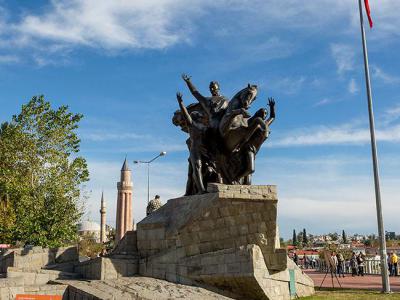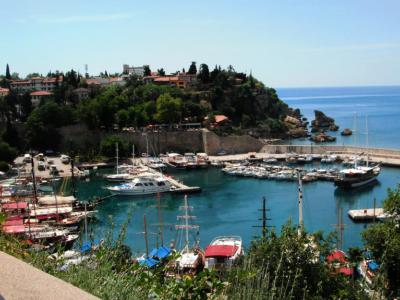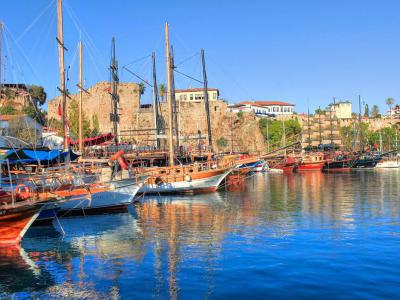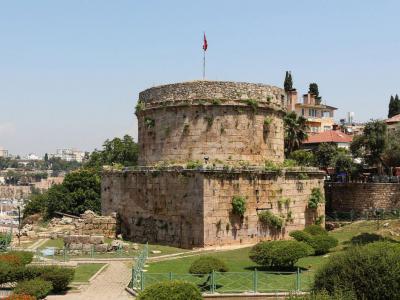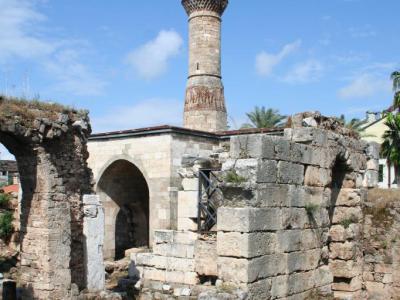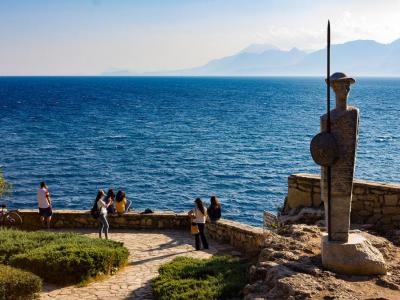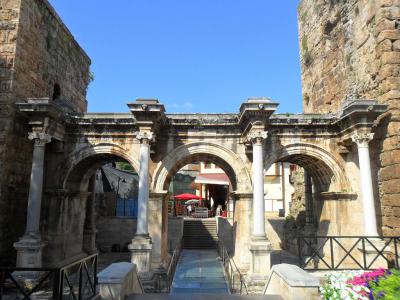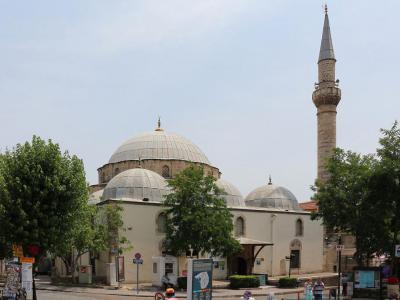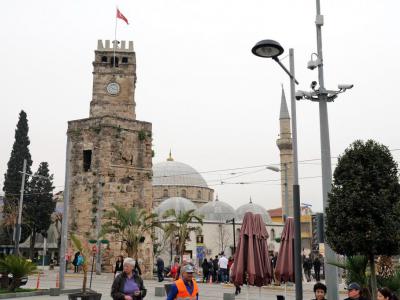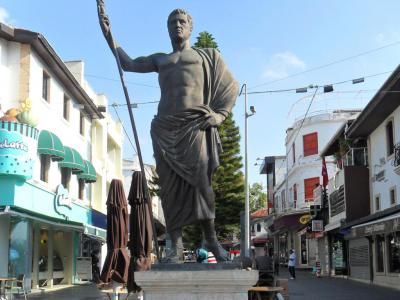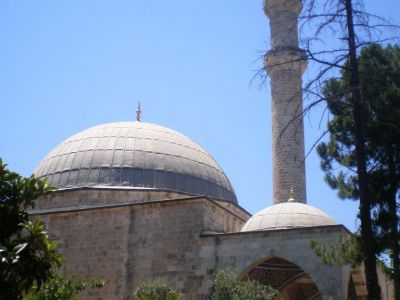Custom Walk in Antalya, Turkey by karenshaw0308_53a85 created on 2025-04-14
Guide Location: Turkey » Antalya
Guide Type: Custom Walk
# of Sights: 11
Tour Duration: 2 Hour(s)
Travel Distance: 4.4 Km or 2.7 Miles
Share Key: AG55Z
Guide Type: Custom Walk
# of Sights: 11
Tour Duration: 2 Hour(s)
Travel Distance: 4.4 Km or 2.7 Miles
Share Key: AG55Z
How It Works
Please retrieve this walk in the GPSmyCity app. Once done, the app will guide you from one tour stop to the next as if you had a personal tour guide. If you created the walk on this website or come to the page via a link, please follow the instructions below to retrieve the walk in the app.
Retrieve This Walk in App
Step 1. Download the app "GPSmyCity: Walks in 1K+ Cities" on Apple App Store or Google Play Store.
Step 2. In the GPSmyCity app, download(or launch) the guide "Antalya Map and Walking Tours".
Step 3. Tap the menu button located at upper right corner of the "Walks" screen and select "Retrieve custom walk". Enter the share key: AG55Z
1) Atatürk Monument and Republic Square
The Atatürk Monument and Republic Square are among Antalya's most famous landmarks. This monument is also known as the National Ascension Monument. The monument and the square celebrate Atatürk's rise to power. Under his leadership, the Turkish Republic came into being, making it one of the first countries in this region to boast a republican form of government.
The monument features bronze handiwork and was created in 1964. Figures featured at the top include Ataturk mounted on a horse, along with a boy and girl representing the country's youth. When you look at the base, you'll see the dates for several important military victories listed.
Republic Square is the city's main square and one of the most popular attractions. One of the most appealing things about the square is its proximity to the harbor, offering excellent views. Because the square is one of the city's most popular gathering places, you'll have a perfect chance of encountering live bands.
The monument features bronze handiwork and was created in 1964. Figures featured at the top include Ataturk mounted on a horse, along with a boy and girl representing the country's youth. When you look at the base, you'll see the dates for several important military victories listed.
Republic Square is the city's main square and one of the most popular attractions. One of the most appealing things about the square is its proximity to the harbor, offering excellent views. Because the square is one of the city's most popular gathering places, you'll have a perfect chance of encountering live bands.
2) Old City Marina (must see)
The Old City Marina was the site of the first harbor in Antalya. Today, it is still an active marina with fishing boats and yachts alike moored here. You'll enjoy being able to watch the fishing boat owners bringing their catch in for all to enjoy. Some of the yachts include impressive luxury vessels.
There are cafes on the marina that serve coffee and tea in an authentic Turkish atmosphere. You can also purchase fish fresh from the fishing boats, prepared as you like. The restaurants that offer fresh seafood also sell traditional Turkish cuisine that you won't want to miss.
You'll enjoy the souvenir shops here, which allow you to select fun trinkets for yourself or as gifts. Traditional Turkish crafts are also popular items to find here. You can also buy traditional spices that form the basis of some of the most popular Turkish cuisine. Don't leave this area empty-handed.
There are cafes on the marina that serve coffee and tea in an authentic Turkish atmosphere. You can also purchase fish fresh from the fishing boats, prepared as you like. The restaurants that offer fresh seafood also sell traditional Turkish cuisine that you won't want to miss.
You'll enjoy the souvenir shops here, which allow you to select fun trinkets for yourself or as gifts. Traditional Turkish crafts are also popular items to find here. You can also buy traditional spices that form the basis of some of the most popular Turkish cuisine. Don't leave this area empty-handed.
3) Kaleici
Old Town Kaleici, situated in the heart of Antalya, is a historic neighborhood that attracts numerous tourists. Renowned for its Ottoman architecture, intricate narrow streets, and authentic mosques, it also offers a vibrant atmosphere with its abundance of restaurants, cafes, and bars featuring concert halls. Visitors can explore the neighborhood's rich historical heritage, which includes monuments from various periods and eras, making it an ideal destination for history enthusiasts and admirers of ancient architecture.
Having stood the test of time, Kaleici has been a witness to countless significant historical events throughout the centuries. The site's first settlement dates back to the 4th century BC, when Attalus II, the ruler of the Kingdom of Pergamum, ordered the construction of a city named Attalia in his honor over two thousand years ago.
In 133 BC, the Romans took control of the port city, and during their rule, the area became known as Kaleici, meaning "inside the fortress." The outpost, enclosed by towering walls featuring 80 towers and numerous cannons, held strategic importance as a crucial point along the route from Europe to Asia. In the 15th century, the Ottoman Empire gained control of Antalya and the Old City. Alongside the Roman and Byzantine structures, traditional Islamic buildings adorned the area.
Modern Kaleici extends across an area of more than 35 hectares and encompasses four districts. Despite enduring several earthquakes, most of the buildings have been meticulously restored, with some preserved in their original form. Notable landmarks that have withstood the test of time include Hadrian's Gate, Hıdırlık Tower, and Yivli Minaret.
Having stood the test of time, Kaleici has been a witness to countless significant historical events throughout the centuries. The site's first settlement dates back to the 4th century BC, when Attalus II, the ruler of the Kingdom of Pergamum, ordered the construction of a city named Attalia in his honor over two thousand years ago.
In 133 BC, the Romans took control of the port city, and during their rule, the area became known as Kaleici, meaning "inside the fortress." The outpost, enclosed by towering walls featuring 80 towers and numerous cannons, held strategic importance as a crucial point along the route from Europe to Asia. In the 15th century, the Ottoman Empire gained control of Antalya and the Old City. Alongside the Roman and Byzantine structures, traditional Islamic buildings adorned the area.
Modern Kaleici extends across an area of more than 35 hectares and encompasses four districts. Despite enduring several earthquakes, most of the buildings have been meticulously restored, with some preserved in their original form. Notable landmarks that have withstood the test of time include Hadrian's Gate, Hıdırlık Tower, and Yivli Minaret.
4) Hidirlik Tower
Situated in Antalya, where the old town converges with Karaalioglu Park, stands the remarkable Hidirlik Tower. Constructed by the ruling Roman Empire during the second century CE, this tower was originally built in a square shape. However, it underwent a transformation in the same century, emerging as a circular tower. Throughout its history, the tower has served as both a fortification and a lighthouse.
Located on the southern side of the city, Hidirlik Tower resides at the intersection of the city's land walls and sea walls. This 14-meter-high (46 feet) structure consists of a circular tower that ascends from a quadrilateral pedestal. An entrance gate on the eastern side of the tower leads to a small room, from which a narrow staircase spirals upward. Evident traces of restoration work can be observed on the upper portion, reflecting interventions made during the Seljuk and Ottoman eras.
The present name of the tower, Hidirlik, which translates to "a place of Khidr," references its association with the Hidirellez festival. Hidirellez is a spring festival celebrated in various Muslim cultures, symbolizing the annual meeting of Khidr and Elijah. It is during this time that the vibrant Hidirellez festival takes place.
Located on the southern side of the city, Hidirlik Tower resides at the intersection of the city's land walls and sea walls. This 14-meter-high (46 feet) structure consists of a circular tower that ascends from a quadrilateral pedestal. An entrance gate on the eastern side of the tower leads to a small room, from which a narrow staircase spirals upward. Evident traces of restoration work can be observed on the upper portion, reflecting interventions made during the Seljuk and Ottoman eras.
The present name of the tower, Hidirlik, which translates to "a place of Khidr," references its association with the Hidirellez festival. Hidirellez is a spring festival celebrated in various Muslim cultures, symbolizing the annual meeting of Khidr and Elijah. It is during this time that the vibrant Hidirellez festival takes place.
5) Kesik Minare
The Broken Minaret Mosque, also known as Kesik Minare Cami or Cumanın Cami, is situated in the streets of Kaleiçi (Old Antalya) in the southern region of Turkey. Its origins trace back to the 2nd century AD when it was initially constructed as a Roman temple. Later, in the 7th century, it underwent conversion into a Byzantine church dedicated to the Virgin Mary. Unfortunately, it endured substantial damage during the Arab invasions of the same century. However, it was restored in the 9th century.
During the early 13th century, as the Sultanate of Rum gained control over Antalya, the church was transformed into a mosque, and a minaret was added. However, in 1361, when the crusader king of Cyprus captured Antalya from the Seljuks, the structure was once again consecrated as a church. This status was short-lived, as it reverted to a mosque during the rule of Şehzade Korkut, the son of Ottoman Sultan Bayezid II.
Tragically, the primary building was destroyed in a fire in 1800. Despite this devastation, the surviving minaret, known today as the Kesik Minare, remains standing on Kaleiçi Hespçi Street.
In 2018, restoration efforts commenced, and in 2019, the top cone and roof of the mosque were restored. On March 5, 2021, the structure was officially reopened as a mosque, coinciding with the day Antalya was conquered by the Seljuk Empire. This marked the first time in nearly 125 years that worshippers were able to gather within its walls once again.
During the early 13th century, as the Sultanate of Rum gained control over Antalya, the church was transformed into a mosque, and a minaret was added. However, in 1361, when the crusader king of Cyprus captured Antalya from the Seljuks, the structure was once again consecrated as a church. This status was short-lived, as it reverted to a mosque during the rule of Şehzade Korkut, the son of Ottoman Sultan Bayezid II.
Tragically, the primary building was destroyed in a fire in 1800. Despite this devastation, the surviving minaret, known today as the Kesik Minare, remains standing on Kaleiçi Hespçi Street.
In 2018, restoration efforts commenced, and in 2019, the top cone and roof of the mosque were restored. On March 5, 2021, the structure was officially reopened as a mosque, coinciding with the day Antalya was conquered by the Seljuk Empire. This marked the first time in nearly 125 years that worshippers were able to gather within its walls once again.
6) Karaalioglu Park (must see)
Karaalioglu Park is one of Antalya's most noteworthy attractions. The Gulf of Antalya, as well as the cliffs that overlook the harbor, are some of the most popular sights. One of the things that visitors enjoy the most about this park is the wealth of photo opportunities that are available.
One of the most noteworthy highlights is Hıdırlık Tower, which dates to the second century. There are sculptures here that visitors enjoy the chance to photograph and take selfies with. These sculptures include the Worker and Son, the monument to poet Nâzım Hikmet, the famous Frog and Hand sculptures, and the statue of Don Quixote.
The entrances to the park have a few places where you can get drinks or snacks. A pub that serves burgers and a beer is one of the more popular places to visit. You can also try a coffee shop near the main park entrance that serves tasty snacks, in addition to great coffee.
One of the most noteworthy highlights is Hıdırlık Tower, which dates to the second century. There are sculptures here that visitors enjoy the chance to photograph and take selfies with. These sculptures include the Worker and Son, the monument to poet Nâzım Hikmet, the famous Frog and Hand sculptures, and the statue of Don Quixote.
The entrances to the park have a few places where you can get drinks or snacks. A pub that serves burgers and a beer is one of the more popular places to visit. You can also try a coffee shop near the main park entrance that serves tasty snacks, in addition to great coffee.
7) Hadrian's Gate (must see)
The Hadrian's Gate is a triumphal arch which was built in the name of the Roman emperor Hadrian, who visited Antalya in the year 130. It has three arched gates. According to the legend, Sultan Belkis, the Queen of Sheba, is said to have passed under those gates and enjoyed a happy day in the palace in Aspendos on her way to visit King Solomon.
The gate was formerly enclosed by the city walls so it was not used for centuries. This may be the reason why there was little wear and tear to the gate, and it was only revealed when the city walls collapsed. It is considered as Pamphylia's most beautiful gate. The upper part has three apertures in the shape of a cupola, and except for the pillars is built entirely of white marble. The ornamentation is very striking.
On both sides of the gate are towers, which were not built at the same time. The southern tower is known as the Julia Sancta tower and is a work of the Hadrian era. It was constructed of plain stone blocks. The northern tower is much older. The base of the northern tower belongs to antiquity, the upper part is likely built by the Seljuks.
The gate was formerly enclosed by the city walls so it was not used for centuries. This may be the reason why there was little wear and tear to the gate, and it was only revealed when the city walls collapsed. It is considered as Pamphylia's most beautiful gate. The upper part has three apertures in the shape of a cupola, and except for the pillars is built entirely of white marble. The ornamentation is very striking.
On both sides of the gate are towers, which were not built at the same time. The southern tower is known as the Julia Sancta tower and is a work of the Hadrian era. It was constructed of plain stone blocks. The northern tower is much older. The base of the northern tower belongs to antiquity, the upper part is likely built by the Seljuks.
8) Tekeli Mehmet Paşa Mosque
The Tekeli Mehmet Paşa Mosque, known as the Tekeli Mehmet Paşa Camii in Turkish, is a significant religious structure located in the captivating city of Antalya. This mosque owes its name to Lala Mehmed Pasa, a prominent figure of the time.
Constructed during the 17th century, the Tekeli Mehmet Paşa Mosque stands proudly in the Kalekapisi district and holds great historical and architectural importance as one of Antalya's most notable Ottoman mosques. Its design showcases the exquisite craftsmanship and artistic flair characteristic of the Ottoman Empire.
The mosque's most striking feature is its main dome, which gracefully ascends on a lofty rim. This central dome is supported by three semi-domes, positioned in the east, west, and south directions, as well as three smaller domes on the northern side. The arrangement of these domes creates an aesthetically pleasing and harmonious architectural composition.
Upon closer inspection, the intricate details of the mosque's embellishments become apparent. The pointed arch-formed lunettes of the windows, both on the northern facade and inside the mosque, are adorned with captivating tiled panels. These panels are meticulously crafted and adorned with verses from the Quran, written in the elegant taliq script. The combination of calligraphy and tile work creates a mesmerizing visual effect, showcasing the devotion and artistic mastery of the craftsmen of that era.
As visitors enter the Tekeli Mehmet Paşa Mosque, they are welcomed by an atmosphere of serenity and tranquility. The interior space exudes a sense of grandeur, with its impressive architectural elements and the soft illumination filtering through the stained glass windows. The beauty and spiritual ambiance of the mosque make it an ideal place for prayer and contemplation.
Constructed during the 17th century, the Tekeli Mehmet Paşa Mosque stands proudly in the Kalekapisi district and holds great historical and architectural importance as one of Antalya's most notable Ottoman mosques. Its design showcases the exquisite craftsmanship and artistic flair characteristic of the Ottoman Empire.
The mosque's most striking feature is its main dome, which gracefully ascends on a lofty rim. This central dome is supported by three semi-domes, positioned in the east, west, and south directions, as well as three smaller domes on the northern side. The arrangement of these domes creates an aesthetically pleasing and harmonious architectural composition.
Upon closer inspection, the intricate details of the mosque's embellishments become apparent. The pointed arch-formed lunettes of the windows, both on the northern facade and inside the mosque, are adorned with captivating tiled panels. These panels are meticulously crafted and adorned with verses from the Quran, written in the elegant taliq script. The combination of calligraphy and tile work creates a mesmerizing visual effect, showcasing the devotion and artistic mastery of the craftsmen of that era.
As visitors enter the Tekeli Mehmet Paşa Mosque, they are welcomed by an atmosphere of serenity and tranquility. The interior space exudes a sense of grandeur, with its impressive architectural elements and the soft illumination filtering through the stained glass windows. The beauty and spiritual ambiance of the mosque make it an ideal place for prayer and contemplation.
9) Saat Kulesi (Clock Tower)
The Clock Tower that dates to 1901 and features a unique square shape. The occasion for the tower's construction was the 25th year of Abdulhamit II's reign. This tower has been constructed of rough stone and has a foundation that incorporates the older part of the city's walls.
Each wall has a clock face, making it easy to tell the time when coming from any direction. There are arches and crenellations above the clock faces, done in beautiful Arabic style. If you should be in the area after nightfall, you'll find the tower beautifully illuminated. Visitors will quickly see why this area of town is so popular for photo opportunities.
Although visitors can only view the tower from outside, a visit will provide you with an excellent chance to appreciate the city center's history. Hadrian's Gate is only about 400 meters from the tower. You will also see a lot of activity near the clock tower that includes bazaars.
Each wall has a clock face, making it easy to tell the time when coming from any direction. There are arches and crenellations above the clock faces, done in beautiful Arabic style. If you should be in the area after nightfall, you'll find the tower beautifully illuminated. Visitors will quickly see why this area of town is so popular for photo opportunities.
Although visitors can only view the tower from outside, a visit will provide you with an excellent chance to appreciate the city center's history. Hadrian's Gate is only about 400 meters from the tower. You will also see a lot of activity near the clock tower that includes bazaars.
10) Attalos II Monument
The Attalos II Monument in Antalya stands as a tribute to King Attalos II of Pergamon, the esteemed ruler and founder of the city in the 2nd century BC. Situated on Republic Street, directly opposite the iconic Clock Tower, this ancient monument continues to captivate visitors with its well-preserved grandeur and strategic location, drawing thousands of tourists daily.
Attalos II Philadelphus, whose name translates to "Attalos the brother-loving," was born as the second son of Attalus I Soter and Queen Apollonius of Cyzicus. He ascended to the throne of the Attalid kingdom of Pergamon alongside his ailing brother, Eumenes II, in 160 BC. Following Eumenes' passing in 158 BC, Attalos married his brother's widow, Stratonice of Pergamon, thus solidifying his claim to power.
During his reign, Attalos II expanded his kingdom with the assistance of his close friend Ariarathes V of Cappadocia. He founded the cities of Philadelphia and Attalia (Antalya), showcasing his dedication to urban development and his role as a patron of the arts and sciences. Notably, Attalos II was also credited with inventing a new form of embroidery. In his later years, Attalos II relied heavily on his trusted chief minister, Philopoemen, to assist him in governing the kingdom. He successfully repelled a Persian raid, demonstrating his steadfast commitment to protecting his realm.
Right behind the statue one can find the famous pedestrians-only street Kazım Özalp Caddesi (formerly-and still sometimes nowadays-called Şarampol Caddesi) - the location of Antalya Central Bazaar.
Attalos II Philadelphus, whose name translates to "Attalos the brother-loving," was born as the second son of Attalus I Soter and Queen Apollonius of Cyzicus. He ascended to the throne of the Attalid kingdom of Pergamon alongside his ailing brother, Eumenes II, in 160 BC. Following Eumenes' passing in 158 BC, Attalos married his brother's widow, Stratonice of Pergamon, thus solidifying his claim to power.
During his reign, Attalos II expanded his kingdom with the assistance of his close friend Ariarathes V of Cappadocia. He founded the cities of Philadelphia and Attalia (Antalya), showcasing his dedication to urban development and his role as a patron of the arts and sciences. Notably, Attalos II was also credited with inventing a new form of embroidery. In his later years, Attalos II relied heavily on his trusted chief minister, Philopoemen, to assist him in governing the kingdom. He successfully repelled a Persian raid, demonstrating his steadfast commitment to protecting his realm.
Right behind the statue one can find the famous pedestrians-only street Kazım Özalp Caddesi (formerly-and still sometimes nowadays-called Şarampol Caddesi) - the location of Antalya Central Bazaar.
11) Murat Paşa Mosque
The history of Antalya is intertwined with the Murat Pasa Mosque, the oldest settlement in the city. It was commissioned by Grand Vizier Kuyucu Murad Pasha in 1570. The Murat Pasa Mosque holds significant tourist appeal as one of Antalya's premier attractions.
Situated at the heart of Antalya, within the boundaries of the Muratpasa district, the Murat Pasa Mosque dates back to the Ottoman era. Interestingly, the mosque exhibits traces of Seljuk calligraphy art. The use of spolia, a common feature in numerous Turkish-Islamic structures in Anatolia, is also evident in the mosque's design. Notably, the columns positioned behind the narthex, along with their Corinthian-style capitals, represent the most prominent spolia elements in this architectural masterpiece.
The Murat Pasa Mosque boasts a wall constructed entirely of cut stones, showcasing the skilled craftsmanship of its builders. Inside, an intricately designed inscription frieze adorns the upper portions of these walls. The interiors, spaces, and dome of the mosque are embellished with exquisite light-colored floral motifs set against a dark background. The mosque underwent repairs in 1960, ensuring its preservation for future generations to appreciate and admire.
Situated at the heart of Antalya, within the boundaries of the Muratpasa district, the Murat Pasa Mosque dates back to the Ottoman era. Interestingly, the mosque exhibits traces of Seljuk calligraphy art. The use of spolia, a common feature in numerous Turkish-Islamic structures in Anatolia, is also evident in the mosque's design. Notably, the columns positioned behind the narthex, along with their Corinthian-style capitals, represent the most prominent spolia elements in this architectural masterpiece.
The Murat Pasa Mosque boasts a wall constructed entirely of cut stones, showcasing the skilled craftsmanship of its builders. Inside, an intricately designed inscription frieze adorns the upper portions of these walls. The interiors, spaces, and dome of the mosque are embellished with exquisite light-colored floral motifs set against a dark background. The mosque underwent repairs in 1960, ensuring its preservation for future generations to appreciate and admire.
